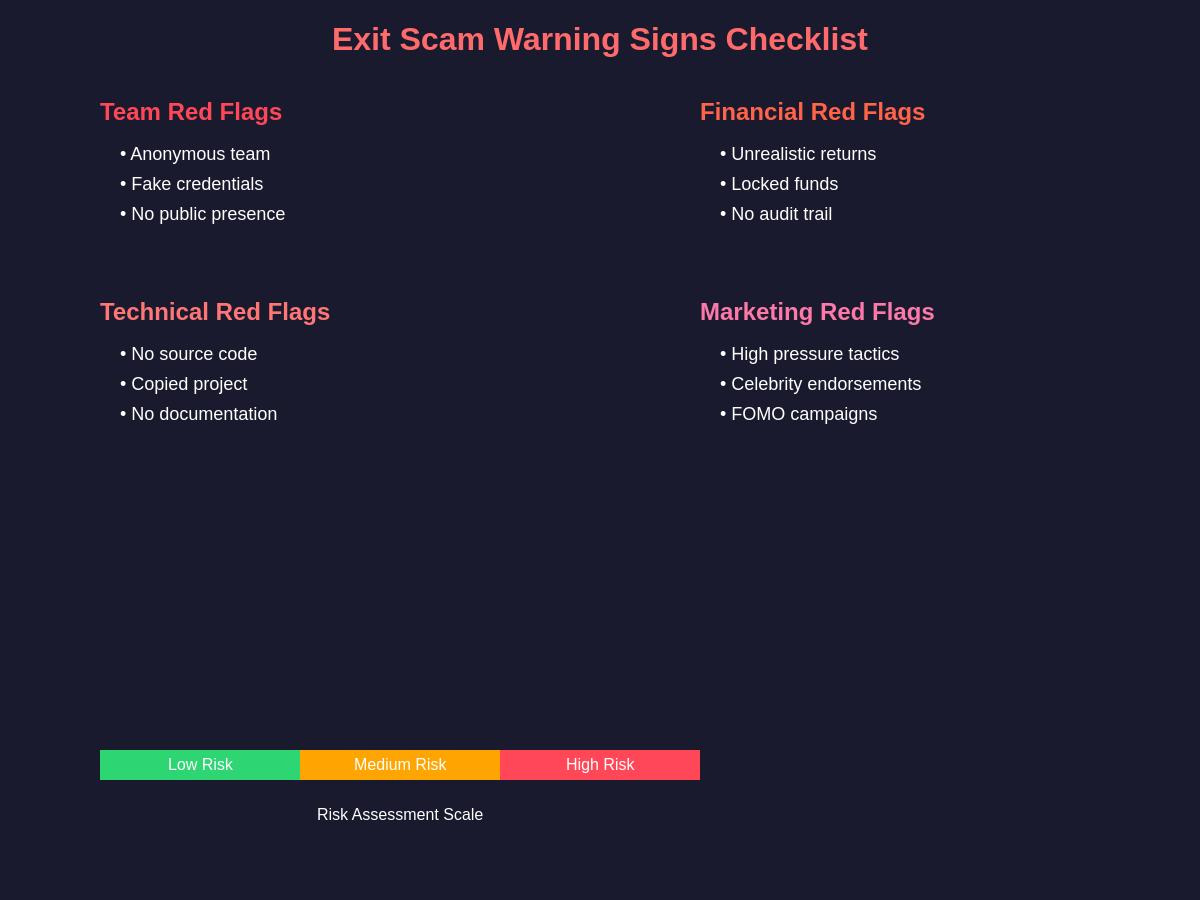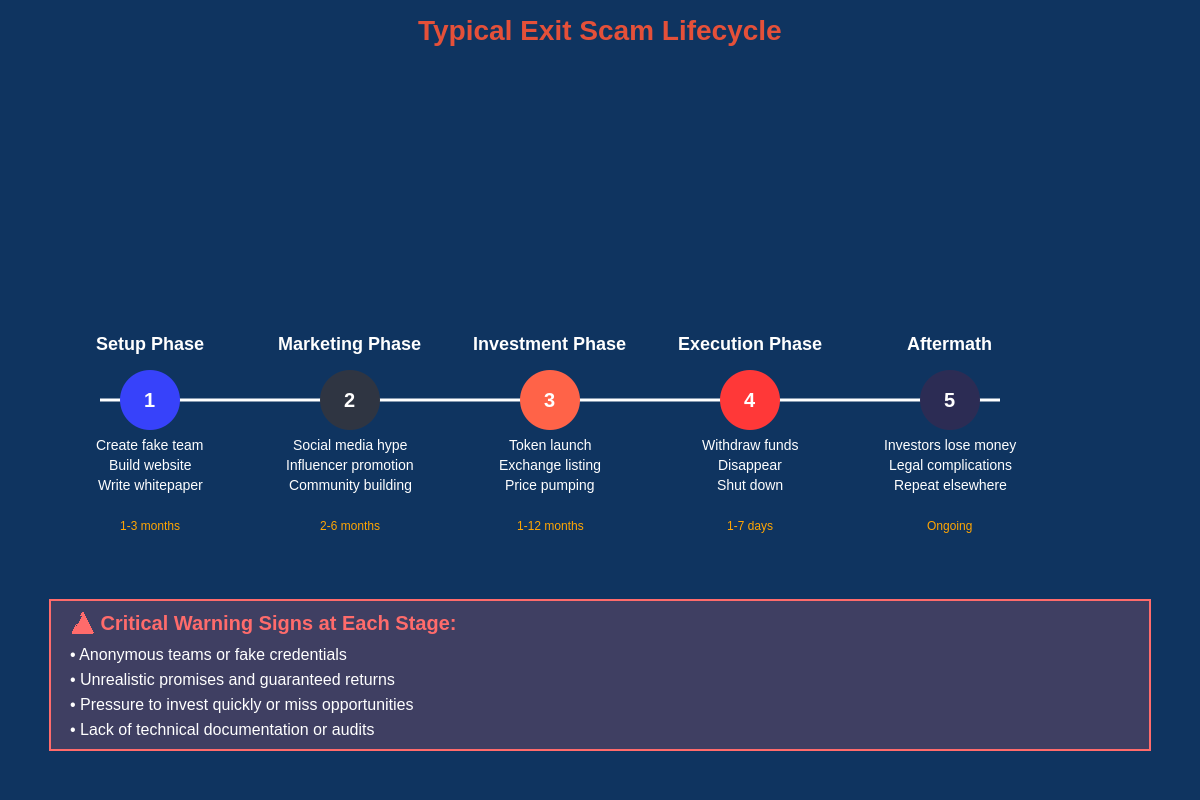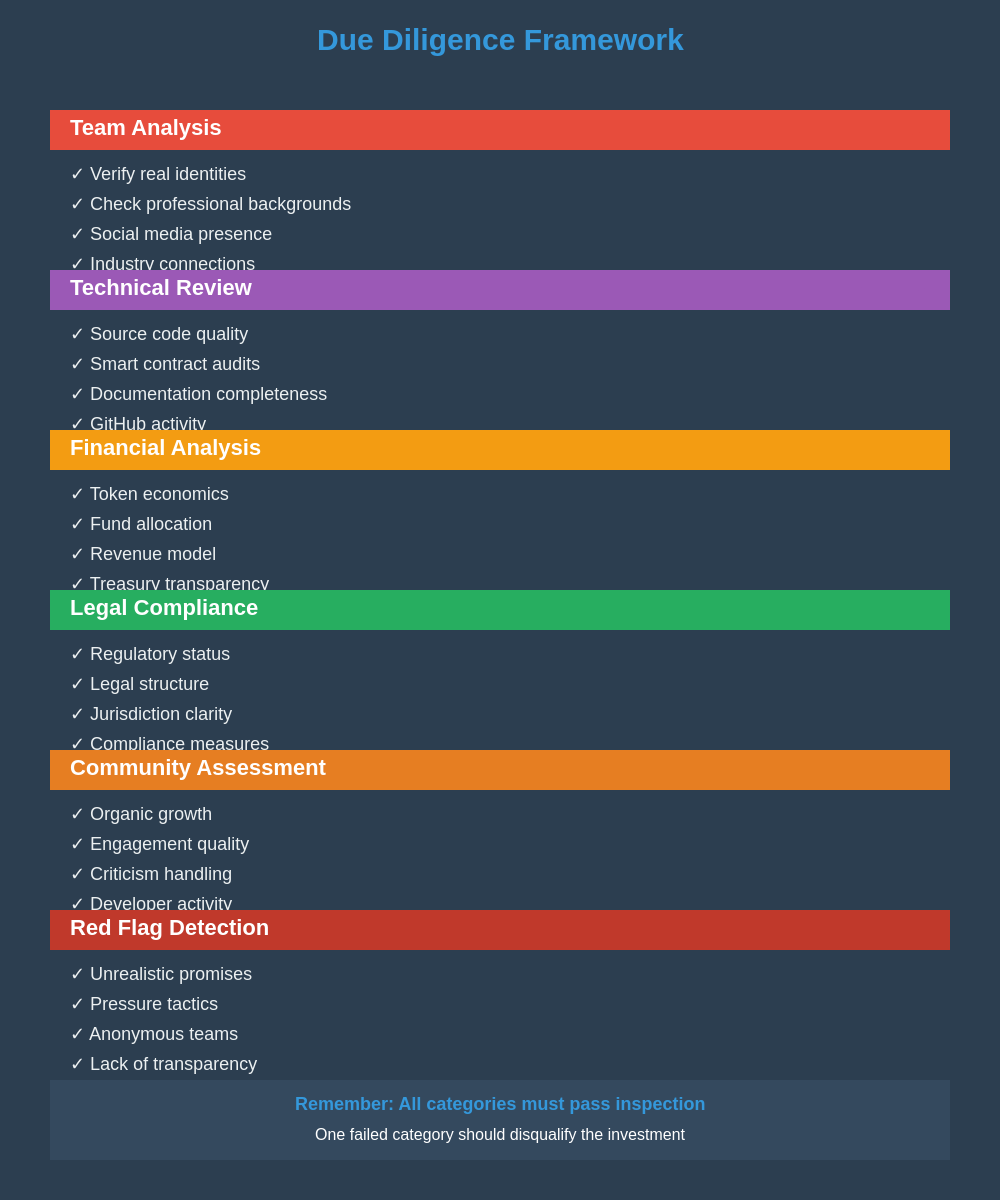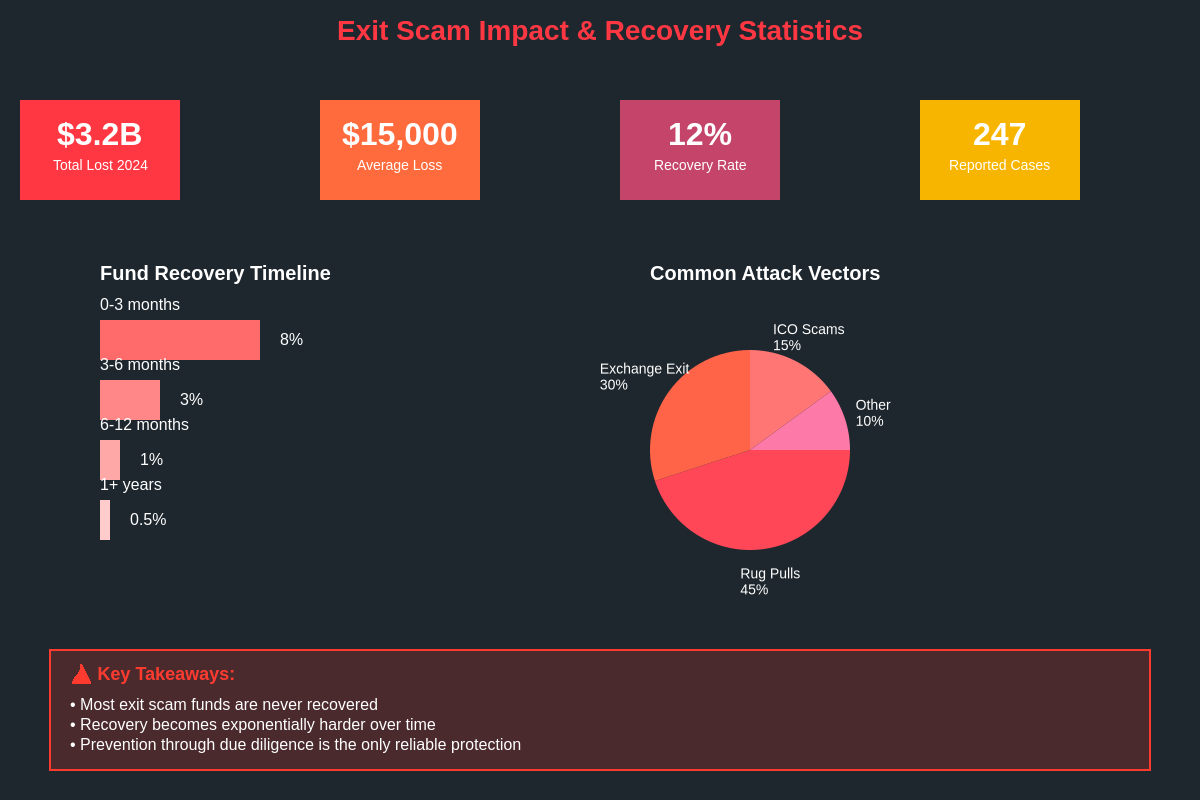Understanding the Exit Scam Phenomenon
Exit scams represent one of the most devastating forms of cryptocurrency fraud, where project developers and exchange operators disappear with investor funds after building apparent legitimacy and trust within the cryptocurrency community. These elaborate schemes have cost investors billions of dollars globally, with sophisticated fraudsters employing increasingly advanced tactics to create convincing facades before executing their ultimate betrayal of user trust.
The psychology behind exit scams involves a calculated exploitation of human nature, particularly the fear of missing out on potentially lucrative investment opportunities and the tendency to trust charismatic leaders who present compelling visions of technological innovation. Professional scammers understand that the cryptocurrency space attracts both experienced investors seeking new opportunities and newcomers drawn by stories of massive returns, creating a diverse victim pool with varying levels of due diligence capabilities.
Modern exit scams have evolved far beyond simple Ponzi schemes to incorporate sophisticated technical infrastructure, professional marketing campaigns, celebrity endorsements, and regulatory compliance theater designed to create an appearance of legitimacy that can fool even experienced investors. The global and largely unregulated nature of cryptocurrency markets provides scammers with numerous jurisdictional advantages while making law enforcement coordination extremely challenging.
Early Warning Signs in Project Development
The initial stages of potential exit scams often display subtle warning signs that careful observers can detect through thorough analysis of project fundamentals, team credentials, and development progress. Anonymous or pseudonymous teams present elevated risk factors, particularly when combined with ambitious promises about revolutionary technology that lacks detailed technical documentation or verifiable proof-of-concept demonstrations.

Unrealistic roadmaps that promise game-changing developments on impossibly short timelines often indicate either incompetence or fraudulent intent, especially when coupled with vague technical descriptions that avoid specific implementation details. Legitimate blockchain projects typically provide detailed technical whitepapers, open-source code repositories, and regular development updates that demonstrate actual progress rather than marketing hype.
When examining cryptocurrency project fundamentals on TradingView, investors should pay particular attention to token distribution models that heavily favor team members and early investors, as this concentration of ownership creates opportunities for coordinated market manipulation and exit strategies. Projects that refuse to undergo independent security audits or provide limited transparency about their technical architecture should be approached with extreme caution.
Social media presence analysis can reveal important warning signs, including bot activity in official channels, coordinated promotional campaigns that lack genuine community engagement, and team members with limited professional histories or suspicious credentialing. Authentic projects typically demonstrate organic community growth, meaningful developer engagement, and transparent communication about both achievements and challenges.
Financial and Operational Red Flags
Financial warning signs in potential exit scams often manifest through unsustainable economic models that promise unrealistic returns without clear value propositions or revenue generation mechanisms. Projects offering guaranteed yields significantly above market rates, especially those requiring users to lock funds for extended periods, should trigger immediate skepticism as legitimate investment opportunities rarely provide such certainty in volatile markets.
Treasury management practices provide crucial insights into project legitimacy, with reputable organizations maintaining transparent reporting about fund allocation, spending patterns, and reserve holdings. Exit scam operators frequently engage in suspicious financial activities including unexplained large transactions, rapid depletion of development funds, or transfers to privacy-focused cryptocurrencies that obscure fund movements.
Exchange-based exit scams often begin with gradual restrictions on user activities, starting with higher withdrawal fees, extended processing times, or sudden implementation of complex verification requirements that create barriers to fund recovery. Monitoring trading volume and liquidity patterns on TradingView can reveal warning signs such as artificial volume inflation, wash trading, or sudden liquidity disappearance that often precedes exit scam execution.
Operational warning signs include sudden changes in customer service quality, reduced communication frequency from leadership, and implementation of new policies that favor the platform over users. Legitimate organizations maintain consistent operational standards and communicate policy changes well in advance, while exit scam operators often become increasingly unresponsive as they prepare their final moves.
Team and Leadership Analysis
Thorough investigation of project leadership represents one of the most effective methods for identifying potential exit scams before significant investment occurs. Legitimate cryptocurrency projects typically feature team members with verifiable professional backgrounds, active social media presence, and public speaking engagements that demonstrate genuine expertise and commitment to their stated missions.
Warning signs in leadership analysis include team members using stock photos or stolen identities, LinkedIn profiles with limited connections or recent creation dates, and educational or professional claims that cannot be independently verified through reliable sources. Sophisticated exit scam operators sometimes create entirely fictional personas complete with fake academic credentials and fabricated work histories that require careful investigation to expose.
The willingness of team members to engage in public forums, participate in industry conferences, and subject themselves to professional scrutiny often distinguishes legitimate projects from fraudulent schemes. Exit scam operators typically avoid situations where they might face detailed questioning about technical implementation or business fundamentals, preferring controlled marketing environments where they can present polished presentations without spontaneous challenges.
Geographic distribution of team members can provide additional insights, with many exit scams featuring teams concentrated in jurisdictions with limited cryptocurrency regulations or weak law enforcement capabilities. While legitimate global teams exist, unusual concentrations in specific regions combined with other warning signs should prompt additional investigation into the project’s true origins and intentions.
Technology and Development Assessment
Technical evaluation of cryptocurrency projects requires careful analysis of code quality, development activity, and architectural decisions that can reveal important insights about project legitimacy and long-term viability. Open-source projects that maintain active GitHub repositories with regular commits, comprehensive documentation, and community contributions demonstrate genuine development efforts rather than superficial technical facades.
Exit scam projects often present minimal or plagiarized code, relying on forked existing projects with cosmetic modifications rather than meaningful innovation. Code audits by reputable security firms provide crucial validation of technical claims, though investors should verify audit authenticity and ensure that audited code matches the deployed systems rather than idealized prototypes.
Smart contract analysis reveals particular vulnerabilities in DeFi projects, where complex financial logic creates numerous opportunities for backdoors, rug pulls, and other forms of technical manipulation. Projects that refuse independent smart contract audits or deploy code with administrative privileges that allow unlimited token minting or fund withdrawal should be avoided regardless of other apparent legitimacy factors.
Technical analysis tools on TradingView can help investors monitor on-chain metrics that reveal technical health indicators such as network activity, transaction patterns, and developer engagement that provide objective measures of project vitality beyond marketing claims and price movements.
Communication and Marketing Analysis
The communication patterns and marketing strategies employed by cryptocurrency projects often provide revealing insights into their true intentions and operational sophistication. Legitimate projects typically maintain consistent, professional communication that focuses on technical development, partnership announcements, and educational content rather than exclusively promotional material designed to drive investment.

Exit scam operators frequently employ high-pressure marketing tactics that create artificial urgency around investment opportunities, including limited-time offers, exclusive access claims, and fear-based messaging about missing revolutionary opportunities. These psychological manipulation techniques exploit cognitive biases that interfere with rational investment decision-making and should be recognized as major warning signs.
Social media analysis can reveal coordinated promotional campaigns featuring bot accounts, paid influencer endorsements without proper disclosure, and artificial engagement metrics that create false impressions of community support. Authentic projects develop organic communities with genuine user engagement, constructive criticism, and diverse participant backgrounds rather than uniformly positive promotional content.
Professional marketing materials that appear disproportionately expensive relative to stated development progress often indicate misallocated priorities, with exit scam operators investing heavily in promotional content while minimizing actual product development. Legitimate projects typically demonstrate balanced resource allocation between development, marketing, and community building activities.
Regulatory and Compliance Considerations
Regulatory compliance attitudes and practices provide important insights into project legitimacy and long-term viability, with reputable organizations proactively addressing legal requirements rather than avoiding or minimizing regulatory considerations. Projects that operate without regard for applicable securities laws, money transmission regulations, or consumer protection requirements demonstrate either incompetence or intentional disregard for legal obligations.
Exit scam operators often exploit regulatory arbitrage by establishing operations in jurisdictions with minimal oversight while targeting investors in regions with stronger consumer protections, creating complex legal challenges for recovery efforts. Projects that refuse to disclose their legal structure, operational jurisdictions, or regulatory compliance strategies should be viewed with significant suspicion.
The willingness to work with established financial institutions, undergo know-your-customer verification procedures, and implement anti-money laundering controls demonstrates commitment to legitimate operations rather than criminal enterprise. While privacy considerations are legitimate, complete anonymity combined with large-scale fund collection creates unacceptable risk profiles for most investors.
Professional legal representation and advisory relationships with established law firms provide additional credibility indicators, though investors should verify these relationships independently rather than relying on unsubstantiated claims about legal partnerships or regulatory approvals.
Due Diligence Best Practices
Effective due diligence requires systematic investigation of multiple risk factors rather than relying on single indicators or superficial analysis of project presentations. Investors should allocate significant time to research activities including independent verification of team credentials, technical architecture review, and financial analysis that goes beyond marketing materials and promotional content.

Cross-referencing information from multiple independent sources helps identify inconsistencies or fabricated claims that might not be apparent from official project communications alone. Professional networking platforms, academic databases, and industry publications can provide valuable verification of claimed credentials, partnerships, and technological achievements.
Historical price and volume analysis on TradingView should complement fundamental analysis by revealing market manipulation patterns, unusual trading activity, or price movements that contradict claimed project developments. Legitimate projects typically demonstrate price movements that correlate with genuine milestones rather than artificial promotional campaigns.
Community sentiment analysis through forums, social media, and professional networks can provide valuable insights into project perception among knowledgeable participants who may have identified warning signs or conducted independent research. However, investors should distinguish between genuine community feedback and coordinated promotional activities designed to create false consensus.
Recovery and Protection Strategies
Investors who identify potential exit scam warning signs should immediately implement protective measures including fund withdrawal, documentation preservation, and communication with relevant authorities to minimize losses and support potential recovery efforts. Quick action often proves crucial as exit scam operators typically execute their schemes rapidly once they detect investor suspicion.
Legal consultation becomes essential when significant investments are at risk, as professional attorneys specializing in cryptocurrency fraud can provide guidance about protective measures, recovery options, and regulatory reporting requirements that vary significantly across jurisdictions. Early legal intervention sometimes prevents complete loss through injunctive relief or asset freezing orders.
Documentation of all transactions, communications, and promotional materials provides essential evidence for law enforcement investigations and potential civil litigation that might recover some investor funds. Blockchain analysis tools can help trace fund movements even after initial theft, though recovery success rates remain disappointingly low for most exit scam cases.
Industry cooperation through information sharing with other investors, regulatory authorities, and law enforcement agencies helps identify emerging threats and potentially prevents additional victims from falling prey to ongoing schemes. Professional associations and investor protection organizations often coordinate these efforts more effectively than individual actions.
Emerging Threats and Future Trends
The sophistication of exit scam operations continues to evolve as fraudsters adapt to improved investor awareness and enhanced regulatory scrutiny that has made traditional approaches less effective. Artificial intelligence and deepfake technology increasingly enable creation of convincing fake identities and promotional content that can fool even experienced investigators.

Cross-chain and decentralized finance protocols create new opportunities for complex exit scam structures that span multiple blockchains and involve intricate smart contract interactions designed to obscure fraudulent activities until after execution. These technical complexities make detection and prevention increasingly challenging for both investors and law enforcement agencies.
Regulatory responses to exit scam proliferation include enhanced disclosure requirements, mandatory registration procedures, and increased penalties for fraudulent activities, though implementation varies significantly across jurisdictions and often lags behind criminal innovation. International cooperation efforts aim to address jurisdictional arbitrage but face significant political and technical challenges.
The integration of traditional financial services with cryptocurrency markets creates additional attack vectors where exit scam operators can exploit regulatory gaps and compliance inconsistencies between different sectors. Monitoring these developments through professional trading platforms helps investors stay informed about emerging risks and protective measures.
Building Community Awareness
Education and awareness campaigns within the cryptocurrency community represent the most effective long-term defense against exit scam proliferation, as informed investors make better decisions and create hostile environments for fraudulent operators. Sharing knowledge about warning signs, investigation techniques, and protective measures helps create collective immunity against sophisticated fraud schemes.
Professional organizations, industry associations, and educational institutions play crucial roles in developing and disseminating comprehensive fraud prevention curricula that address both technical and psychological aspects of exit scam operations. These educational efforts must evolve continuously to address new threats and methodologies employed by criminal organizations.
Victim support networks provide valuable resources for individuals who have suffered losses to exit scams, including emotional support, legal guidance, and coordination of recovery efforts that might not be available through traditional channels. These networks also serve as early warning systems for emerging threats identified by community members.
Collaborative investigation efforts that combine resources from multiple victims, professional investigators, and volunteer researchers often prove more effective than individual actions in identifying and exposing exit scam operations before they can cause maximum damage to the broader community.
Conclusion and Future Vigilance
The persistent threat of exit scams requires continuous vigilance, education, and adaptation from cryptocurrency investors who must balance legitimate innovation opportunities with sophisticated fraud risks that continue to evolve alongside market development. Success in this environment demands systematic due diligence, healthy skepticism, and willingness to prioritize security over potentially lucrative but suspicious opportunities.
Technological solutions including improved identity verification, enhanced smart contract auditing, and blockchain analysis tools provide valuable weapons in the fight against exit scams, though they cannot replace human judgment and careful investigation of investment opportunities. The most effective protection combines technical tools with fundamental analysis and community cooperation.
The cryptocurrency industry’s long-term success depends on building trust through transparency, accountability, and effective fraud prevention that protects both institutional and retail investors from sophisticated criminal enterprises. This responsibility extends beyond individual projects to include exchanges, service providers, and regulatory authorities working together to create safer market environments.
Future market development will likely see continued arms races between fraudsters and protective measures, making ongoing education and adaptation essential for anyone participating in cryptocurrency markets. Staying informed through professional resources and community networks provides the best foundation for navigating these challenges while participating in legitimate innovation opportunities.
Disclaimer
This article is for educational and informational purposes only and should not be construed as financial advice. Cryptocurrency investments carry significant risks, including the potential for total loss of capital. Always conduct thorough research and consider consulting with qualified financial advisors before making investment decisions. Past performance does not guarantee future results, and the cryptocurrency market remains highly volatile and speculative. The authors and publishers of this content are not responsible for any financial losses that may result from the use of this information.